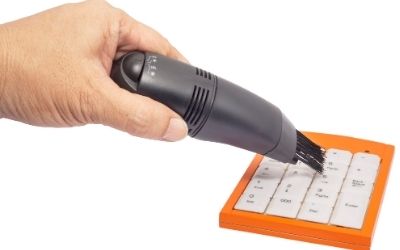Table of Contents
You’ve got a brand new laptop or maybe a flagship phone with the (pretty) new USB-C port, and you want to keep it running clean and dust-free for as long as possible. But just how can you do that? This handy guide will show you everything you need to know about protecting your ports from dust when using or traveling with your computer!
So the question is, how do you keep out dust from your USB-C ports?
For one thing, dust will always find its way into the smallest crevices of space. That includes the tiny little holes that were cut out for your USB-C plugs. Fortunately, there are both preventative ways and solutions to this dilemma. For one thing, you can use canned air or an electric vacuum or duster. You can also look for something called USB-C dust plugs. And finally, you can purchase a case for your device.
I know, I know. You’ve invested a ton of money into these cool little devices and in order to keep them running well for years to come, you’ll need to make sure they’re always protected.
To help you out, I’ve created a list of 5 ways to keep dust out of your USB-C ports.
Option 1: Use a canned of compressed air to get the dust out of your USB-C port
This may be one of the most common products when it comes to getting dust off machines. Canned air exists in two different forms: cold and warm. The purpose of it is the same, to clean out dirt, dust, and other particles inside of machines.
The difference is the temperature of the air that’s being used. Cold canned air is commonly used for computers and comes in cans that are filled with several different chemicals.
Using canned air works extremely well. Because the pressurized air is coming out from manufacture sealed and pressurized can, there’s likely little to no dust ever transferring over to your device and its ports.
One thing I would like to stress is that there’s a specific technique in using compressed air.
- Make sure your device is turned off and unplugged from any electrical outlet
- With your can of compressed air, spray into the port at an angle.
- Spray in bursts, not continuously.
- Pivot the direction of your can and continue burst spraying until all the dust are gone.
So the problem with spraying directly, straight into the port is that you’re leaving very little room for air to come out. If you angle it a bit, the air will enter from a corner of the port and exit from the other corner, taking the dust away with it.
However, if you blew your can straight into the port, you may risk compacting the dust and making it even more difficult to remove later on.
Canned air is also bad for the environment
The component used inside of compressed air is regarded by environmentalists as bad for the environment. There a measurement called the Global Warming Potential (GWP) and the higher it is the worst it is in promoting global warming.
One can of air usually has the chemical difluoroethane in it which has a GWP of 140. A 140 GWP is equivalent to 140 pounds of carbon dioxide.
The major threat of concern laid in research that carbon dioxide can further advance the greenhouse effect.
Option 2: Invest in an electric duster
The alternative way to keep dust out of your USB-C ports is very simple: invest in a duster that has tiny, soft bristles that can reach into the smallest crevices of your devices and gently whisk away all surface dirt.
These devices generate a powerful stream of air using electricity. They are great for getting rid of dust from really hard-to-reach places. And the true benefit of these devices is that they will last much longer than a single can of compressed air.
Blowing circulated air may eventually cause damage to your electronics
This was a discussion I had a long time ago with a colleague. The point that came across was that depending on your environment, using an electric duster on delicate electronics may end up hurting it more than good.
It’s the fact that these dusters are sucking in air from the environment and blowing it back into wherever it is you’re pointing it. If you live in a very humid location, this would ultimately focus the water in the air into some of your device’s most vulnerable spaces.
That’s the difference between this and compressed air. Compressed air is deemed safe for electronics. If you live in a cool and dry location this method is much alleviated and may not be such a big deal.
Option 3: Invest in a vacuum duster

This option is exactly as it sounds. They make these hand-held vacuums that are a microsized version of the heavy ones you use to clean your carpets. Even the area of suction is sometimes shaped like a funnel with the smaller end pointed at the dust.
This is something that’s definitely recommended in case you don’t want to waste a lot of money on compressed air and you’re worried that recycling air will ultimately damage your device.
This device is all-electric just like the electric duster but instead of exhibiting a powerful stream of air outward, it sucks the air inward, into a chamber for disposal.
Vacuum dusters may not be powerful enough
As with the size, there are power limitations. Vacuums often need much more powerful motors than their counterpart blowing dusters. If dust is really packed into those USB port crevices, you might not have a chance of getting it out.
If these vacuums come with soft thin-tipped bristles, be sure to use them to reach into that tiny space.
Ultimately, you’ll want to use your vacuum more often and more regularly than if you were to use the other methods. This way, dust won’t gradually build up inside the ports and your vacuum machine should have no problems sucking it out.
Option 4: Using USB-C dust plugs
Another way to keep dust out of your USB-C ports is to use a dust plug. These are usually little rubber stoppers molded in the shape of the male component of the USB-C wire, the part that sticks into the USB-C port.
If you have a laptop, it’s probably got more than one USB-C port and you’re most likely not using them both. If you’re on the go, you probably don’t need them at all.
It’s in these cases, that I recommend USB-C dust plugs. These plugs almost guarantee that dust won’t be able to even have access to the port.
Putting dust plugs in is easy, taking it out is hard
These things are tiny. Sure they fit really well inside the port and they do a whole lot of protection for you, but when you plan to charge your phone, you can really have a hard time taking them out.
Sure, you can just get a sharp object and pry it out, but you run the risk of scratching the paint job on your device. However, it might be a good idea to find yourself a plastic prying tool for small devices. These work well because the plastic has very little chance of damaging your phone.
At this point, if you have a modern phone, I would suggest finding out if you have wireless charging features. If you do, you have the option of buying a wireless charger and using that to charge your phone. You’ll never have to remove your dust plug again.
Of course this only deals with smartphones. If you own a laptop, then you might want to use the dust plugs mentioned earlier.
Option 5: Looking for a case that protects all ports
If you want to ensure that your ports are better protected, you can look for a case that covers pretty much every single port on your computer or phone. Most of these cases are silicone or hard plastic, designed to protect phones and tablets from the elements (including the dirtiest of particles).
The benefit here is that the material that covers your device most likely will create a bigger gap between things in the air and dust in your pocket.
Normal cases only partially protect the ports
Unfortunately, not many cases are built with dust-proofing in mind. You can argue that if you put on a case, the gap that prevents your actual device from physically touching other objects thanks to the case may help in also preventing dust if it were placed inside your backpack.
That’s still up for debate.
But if you really want true dust protection, the only ones I can imagine to help are those big Otterbox cases or some kind of waterproof swimming cases.
In conclusion
Now that you know how to keep dust out of your USB-C ports, share this article with someone that needs help keeping their devices running clean and free from dirt!
If we come across any additional tips or tricks for keeping dust out of your USB-C ports, we’ll be sure to pass them on to our readers. Until then, we have a ton of handy articles that should help.
Other interesting articles:
